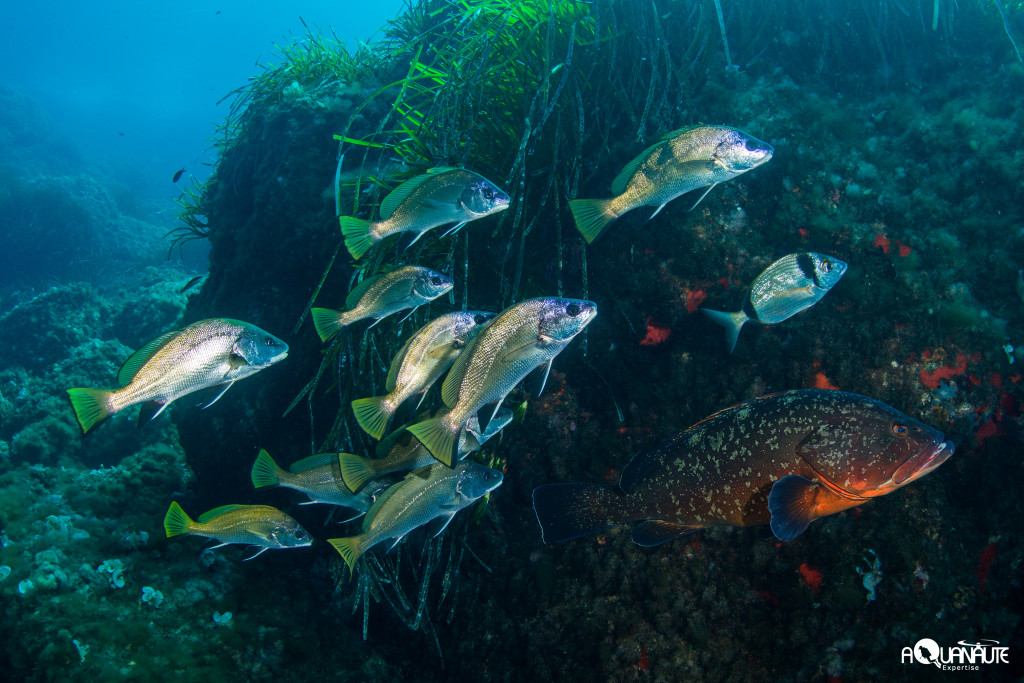Monitoring Brown Meagres and Groupers populations
Monegasque waters hide astonishing marine biodiversity and are home to remarkable species, some of which have high heritage value. Among them, the dusky grouper (Epinephelus marginatus) and the brown meagre (Sciaena umbra), which are subject to specific regulations contributing to their protection.
The brown grouper is an emblematic species of the Mediterranean. It lives mainly on rocky bottoms rich in cavities. Its biological characteristics make it vulnerable to fishing pressures:
• its habitat: shallow, accessible and frequented by human activities;
• its behavior: faithful to a site, calm, curious and placid;
• its reproductive behavior: late reproductive age, successive hermaphroditism, dependence on the density of individuals;
• its recruitment: not very abundant with few juveniles;
• its particularly slow growth;
• its demographic structure: low population turnover.
As a result, this species has faced a decline in the Mediterranean and has been classified as an “endangered species” by the IUCN.
The brown meagre also has strong attractiveness and vulnerability. It is usually found in shallow coastal waters where it most often lives in small sedentary groups. It favors habitats such as rocky, sandy bottoms and Posidonia meadows. During the day, its preferred shelters can be caves, crevices or the shelter of a rock. Like the brown grouper, the life traits of the brown meagre (longevity, slow growth and high trophic level), its very accessible habitat and its behavior (calm swimming, aggregation behavior, accessibility) have pushed the International Union for the Conservation of Nature (IUCN) to classify the corb as a “vulnerable species”.

Dusky grouper and brown meagre are listed in Annex III of the Convention on the Conservation of European Wildlife and Natural Habitats (Berne Convention, 1977) and in Annex III of the Convention for the Protection of the Marine Environment and the Mediterranean coast (Barcelona Convention).
For many years, inventories of grouper populations have been carried out along the Monaco coast by the Groupe d’Etude du Mérou (GEM). Initiated by the AMPN in 1995, GEM inventories are now carried out every 3 years at the request of the Direction de l’Environnement within the Larvotto MPA as well as on the rest of the Monaco coastline.
In addition to the GEM, monitoring was initiated by the AMPN in 2018 according to a standardized protocol making it possible to measure certain indicators of the state of health of the populations such as fish density and biomass. The method consists of carrying out visual counts of the abundances and sizes of individuals observed along a transect, set in this study at 25 m in length and 5 m in width (which corresponds to an explored surface of 125 m² per transect). For each of the sites, 6 replicates are carried out between 10 and 15 m depth on a comparable habitat made up of riprap. Two annual campaigns are organized, one in June before the summer season and a second in September after the summer season.
The first monitoring according to this protocol was carried out in 2018 by Professor Patrice Francour of the University of Côte-d'Azur at the Oceanographic Museum of Monaco, between Pointe Saint-Martin and plage des pêcheurs. They have been continued since 2019 by Thalassa Marine Research & Environmental Awareness which completed the study with a second site located at the level of the riprap of the Sporting dike, inside the Larvotto MPA.
